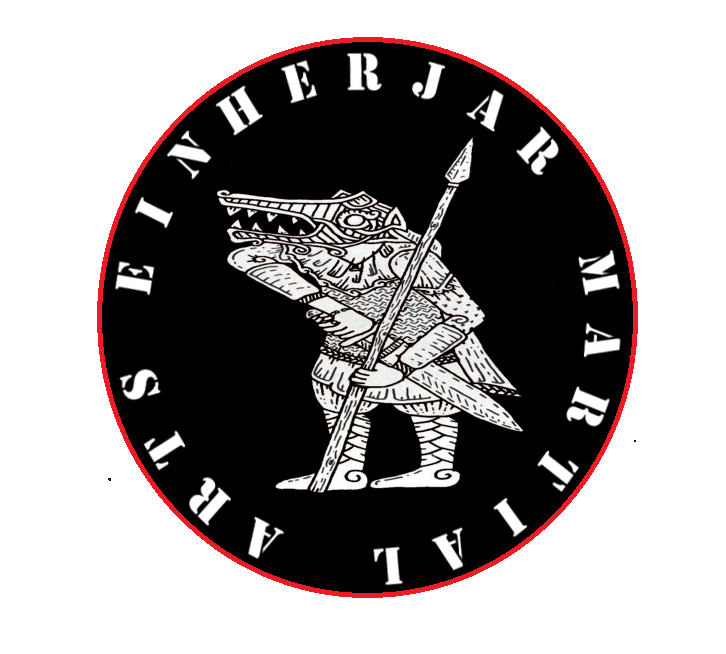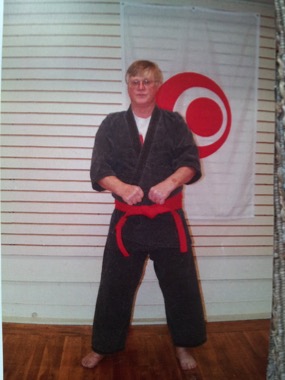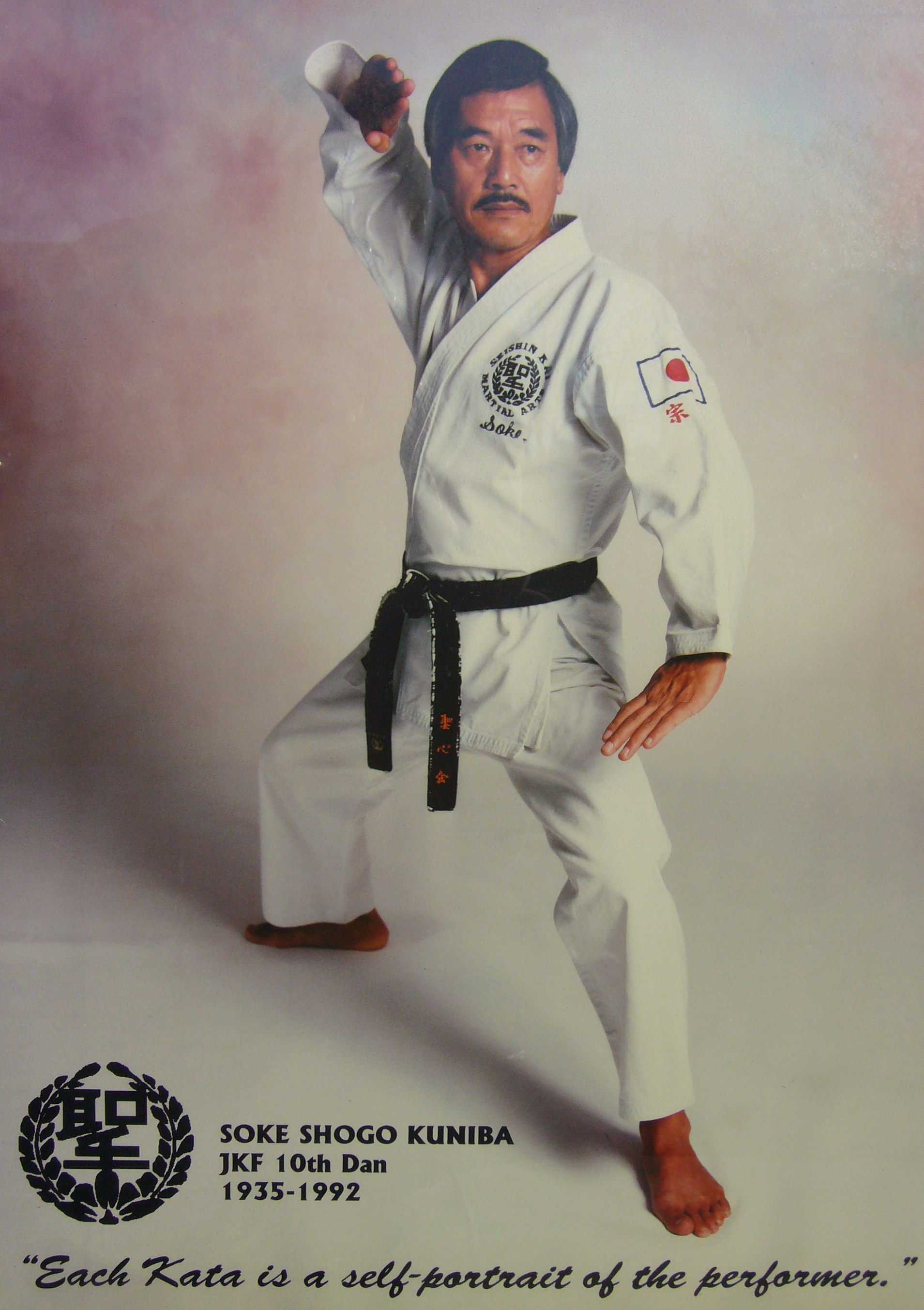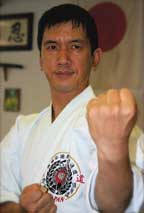 Einherjar Martial Arts
Einherjar Martial Arts
EINHERJAR MARTIAL ARTS: Motobu Ha Shito Ryu / Kuniba Kai International


Lashbrook Sensei
Lashbrook Sensei was born November 16th 1982 in USA state of IL. began martial arts training at the age of 8 off and on in Hakutsuru Kai Ten Shin no Shin Nagare Ryu Goshin Jutsu.
Later at the age of 27 Sensei Lashbrook began Motobu Ha Shito Ryu of Kuniba Kai International.
In 2015 Sensei Lashbrook started to train with the Illinois Shito Kai National Team learning from Jeff Bedard.
On June 27th 2018 Sensei Lashbrook started training Brazilian Jui Jitsu with Pedigo Submission Fighting.
On April 28th 2022 Sensei LashbrookStarted Training Wing Chun Kung Fu - Learning From Sifu Randy Williams Founder of Close Range Combat Academy International.
Hakutsuru Kai Ten Shin no Shin Nagare Ryu Goshin Jutsu

James R Gaines Soke- Founder
James R. Gaines first studied under Hohan Soken on Okinawa while serving with the U.S. Marine Corps. In 1982 he was awarded the title of Renshi, “Karate Master”,with the rank of 6th Degree black belt. In 1990, Hakutsuru Kai was chartered under Yuichi Kuda and Mr. Gaines was accepted as a personal student in order to further his knowledge of White Crane Kempo.
Gaines sensei was born September 20, 1944, in Mt. Vernon, IL. He began his studies of the martial arts, namely Kodokan Judo, in 1960 under C.C. Franklin in Carbondale IL. He studied the throwing art for two years and then began his studies of Matsubayashi Shorin Ryu karate in San Diego, California while continuing in Kodokan Judo with Bill Hodge for another two years.
In 1964 Gaines sensei continued martial arts training, as a Marine on Okinawa, with Kanei Uechi and Eizo Shimabuku. He studied for two years and attained the rank of Nidan in Shorinji Ryu, or Sukunaihiyashi Ryu, as it was sometimes called. 1967 brought Gaines sensei to mainland Japan where he studied Jiu Jitsu and Goju Ryu with Siyoga Kuniba and Shihan Iwata respectively.
From 1967 – 1973, he studied JKA Shotokan with Jack Schneider sensei and Vito Rollo. Gaines sensei was also assigned as Midwest representative for Motobu-Ha Shito Ryu and Goshin Jutsu at this time. In 1980 Sensei Gaines was accepted as a student of the Matsumura Seito art of Shorin Ryu by Fuse Kise and awarded the rank of Rokudan.
In 1982 Gaines sensei was accepted at Renshi level by Yuichi Kuda of Matsumura Kempo, and now attains the rank of Rokudan in that art. As of September of 1994 Gaines sensei holds the title of Soke, or “head of family” for his founding of Hakutsuru Kai Ten Shin no Shin Nagare Ryu Goshin Jutsu. Although Gaines sensei is the founder of Hakutsuru Kai, or Soke, he claims rank no higher than Hachidan (8th degree black belt).
At age 27 Sensei Lashbrook began training with Renshi Felipe Villarreal in Motobuha Shito Ryu of Kuniba Kai International.
Renshi Felipe Villarreal
Renshi Villarreal studied martial arts under Soke Richard Baillargeon founded the National Karate and Jiu Jitsu Union in 1974, after having resigned from the Seishin Kai Karate Union. Soke Baillargeon began his martial arts in Urmagawa, Japan in 1956.
His first instructor was Sensei Kishan Kayo, who was, then, 4th Dan in Motobu-Ha Shito-Ryu and affiliated with the Seishin Kai Karate Union. His son, Shogo Kuniba, became Soke of Motobu-Ha Karate Do, Seishin Kai Karate Union.
Master Baillargeon studied with Soke Shogo Kuniba until 1964. By then, Master Baillargeon had earned the grade of Sandan. Soke Baillargeon returned to the United States in 1964 and became the United States representative for Seishin Kai. He served in that capacity for ten years.
By 1974, he had been promoted to 6th Dan by Soke Kuniba. In the summer of 1974, he resigned from his position in Seishin Kai. Shortly thereafter, he formed his own association: The National Karate and Jiu Jitsu Union. In July of 1986, Master Baillargeon was awarded on 8th Dan in Motobu-Ha Shito-Ryu Karate by Soke Shogo Kuniba. Master Baillargeon also holds master ranks in Indo Pakistani weapons and a 6th Dan in Goshin Budo Jiu Jitsu.
In addition Sensei Villarreal studied under Soke Shogo Kuniba and his son Soke Kozo Kuniba.

Soke Shogo Kuniba
History Surrounding Soke Shogo Kuniba
Kosei Kokuba was born in Naha City, Okinawa in 1901, the youngest son of a samurai family descended from the Sho-Shi royal family of Okinawa. At the age of 14, he began karate training in the dojo of Motobu Choki. In 1924 he moved to Tokyo, Japan and in 1940 he settled in Osaka where he began training students in the Okinawan style which he had studied. On June 6, 1943 Kokuba founded the Seishin Kan Dojo.
Later, when his friends from Okinawa Motobu and Mabuni Kenwa came to Osaka, he gave them room and board in exchange for their teaching at the dojo. Kokuba taught the Motobu style of karate and upon Motobu’s death in 1947, he became the Soke or family head of Motobu-Ha Karate-Do.
The kanji characters for Kosei Kokuba (in Okinawa) are pronounced Yukimori Kuniba in Japan. To avoid confusion he changed the pronunciation of the family name to Kuniba.
On February 5, 1935, Kuniba’s son Kosho was born in Yamanashi prefecture near Mt. Fuji in the city of Fuji Yoshida-shi. The son began his karate training at the age of five in his father’s dojo. At the age of eight he was sent to study with Sensei Tomoyori Ryusei of Kenyu Ryu. Kuniba wanted his son to be a true samurai as were his ancestors and, as a true samurai, to have knowledge of all martial arts. Therefore, at the age of eight, Kosho also began to study judo in an Osaka dojo. He continued his training in Judo for ten years and earned a sandan rank.
In 1947 at the age of twelve, he began training with Mabuni Kenwa in Shito-Ryu and was soon promoted by Sensei Mabuni to shodan in karate. In 1950 he was promoted to nidan by Mabuni and Tomoyori and in 1952 earned a sandan rank.
As a high school student, Kosho was president of his karate club. At the age of seventeen, he began teaching karate at Osaka Prefecture University and there is still a branch dojo of Seishin Kai there today. After high school, he trained in karate at Keio University and later trained at Doshisha University while he was a student there.
In 1955 Kosho was promoted to yondan by Tomoyori. During that year he was also promoted to sandan in Iaido and yondan in Kobudo. In 1956 he traveled to his father’s homeland of Okinawa where he trained with Nagamine Shojin in his style of Shorin-Ryu. While in Okinawa, he studied Kobudo with Taira Shinken and Nakaima Kenko of Ryuei Ryu. With Yamaguchi Junko, he studied the use of the Tonfa.
In 1957 Shihan Kosho’s book KARATE-DO BIN RAN, a text of the basic techniques of his style, was published. The book sold out and is no longer in print. In 1958 he was promoted to godan in Motobu-Ha Karate-Do and Rokudan in Kobudo. He studied Mugai-Ryu Iaido with Soke Ishii Gogetsu in Sakai City beginning in 1952.
He was instrumental in helping to form the Nippon Karate-Do Rengo Kai and in 1958 served as its first office manager.
After the elder Kuniba’s death in October 1959, Shihan Kosho was elected by the Shihan board of Seishin Kai to the position of Soke of Motobu-Ha Shito-Ryu Karate-Do. He is the third person to have held this position. At the age of twenty-four, he became the youngest karate Soke in Japan and took the karate name of Shogo which means strong warrior.
In 1962 Soke Kuniba was promoted to Karate-Do Rokudan by the Nippon Karate-Do Rengo Kai. Recipient of many honors throughout his career, he received one of the highest tributes when he was featured in the Encyclopedia Japonica in a four page article on Karate and Kobudo. In 1966 he was promoted to Karate-Do Nanadan.
In 1970 he was chosen by the Zen Nippon Karate-Do Remnei (Now JKF) to give a demonstration at the First World Karate-Do Championship held in Tokyo at the Budo-Kan. Again in 1972, he was chosen to represent Japan in a demonstration at the Second World Karate-Do Championship held in Paris, France.
At the age of thirty-eight in 1973, he was promoted to hachidan by the Rengo-Kai. At this same time, he gave a formal name of Goshin-Do to his system of self defense which he developed from his knowledge of Judo, Jui Jitsu, and Aikido and incorporated this art into the structure of Seishin Kai.
In addition to karate work, Soke Kuniba was one of the first to work with martial arts in Japanese movies. He appeared in twenty-two movies in Japan utilizing his martial arts skills. The last of these was a 1978 documentary film titled EIEN NARU BUDO (ETERNAL MARTIAL ARTS) which received the 1979 Miami Film Festival Award as the best documentary film of 1978. The movie was shown in the USA under the title of BUDO: GREAT MASTERS OF THE MARTIAL ARTS.
Soke Kuniba has also been featured in numerous magazine and newspaper articles in Japan, USA, and Europe. He has also been featured in the 1984 issue of WHO’S WHO IN AMERICAN MARTIAL ARTS and in the 1985 issue of MASTERS, FOUNDERS, AND LEADERS OF AMERICAN MARTIAL ARTS.
In 1984, he was promoted by the Nippon Karate-Do Rengo Kai to Kudan. In 1985 he was promoted to Nanadan by the Japan Karate-Do Federation.
In 1983 he opened a Hombu Dojo in the USA in Portsmouth, VA. where he lived until his death in 1992. After his death he was promoted to tenth dan by the JKF, an honor held by only four other Japanese sensei, all deceased. While living in Portsmouth he concentrated his efforts on teaching his style of karate-do to the world. Now the tradition continues through his sons Kozo and Kosuke as well as sensei from dojo around the world that Shogo Kuniba started. Seishin Kai is growing in the US as well as in Europe, Mexico, India, Sweden, Russia, Srilanka, Israel, Turkey, West Indies and South America.
Renshi Villarreal receiving his menjo from Soke Kozo Kuniba at the grave of Soke Shogo Kuniba.


Soke Kozo Kuniba
Kozo Kuniba is the second son of the late Kosho Kuniba, who was known to the martial arts world as Shogo Kuniba. Shogo Kuniba was the son of noted Osaka karate instructor Kosei Kokuba (the Okinawa rendering of his family name).
Thus, three generations of martial lineage come to life in Kozo Kuniba. Whereas Kosei Kukuba was a follower of the infamous Choki Motobu, young Kosho (Shogo) learned the Ryukyu Karate-Do Motobu-Ha of his father as well as Shito-Ryu Karate-Do from Ryusei Tomoyori and Kenwa Mabuni.
It was Shogo Kuniba who synthesized these two streams of karate into Motobu-Ha Shito-Ryu during the mid 1950s. Kosei Kokuba founded Seshin-Kan in 1943 and it became Seishin-Kai by 1947. From Seishin-Kan Kancho, Kosei Kokuba became the first Sesishin-Kai Kaicho (president).
Upon his death in 1959, Teruo Hayashi (senior student of Kosei Kokuba) became the second Kaicho, although the younger Shogo Kuniba assumed the role of Nidai Soke of Motobu-Ha. When Teruo Hayashi stepped down in 1970 to form his own organization (Hayashi-Ha Shito-Ryu Kai), Shogo Kuniba became the third Seishin-Kai Kaicho.
Seishin-Kai and Motobu-Ha Shito-Ryu were spread the world over as Shogo Kuniba traveled to teach and promote his art. Then, when Shogo Kuniba passed away in 1992, Kuni Tatsuno emerged as the fourth Sesihin-Kai Kaicho and took the title of Soke as well. Tragically, Kunio Tatsuno was killed in Osaka in 1999.
Although Seishin-Kai continued under the leadership of Sadatomu Harada (fifth Kaicho), an historic decision was made to form the Nihon Karate-Do Kuniba-Kai in November of that year.
Though the Seishin-Kai continued, the style stayed with the family. Kozo Kuniba became Kuniba-Kai Kaicho and his older brother, Kosuke, took the role of Japan Soke of Motobu-Ha Shito-Ryu. Soon, the Kuniba-Kai Kokusai Budo Renmei was established and Kozo Kuniba became Kaicho/Soke.